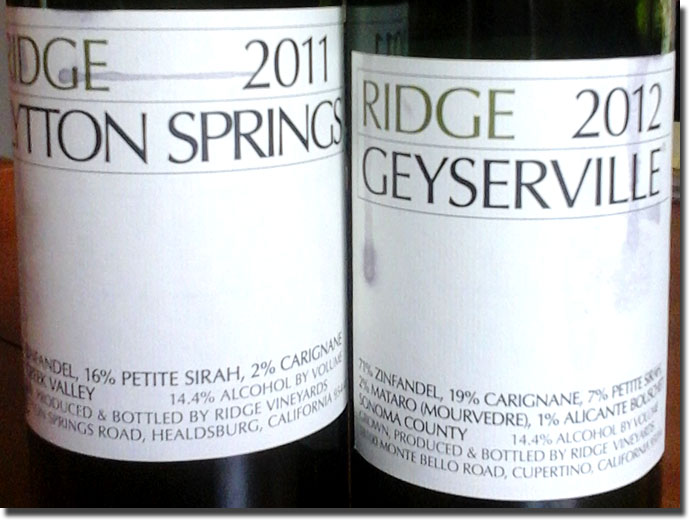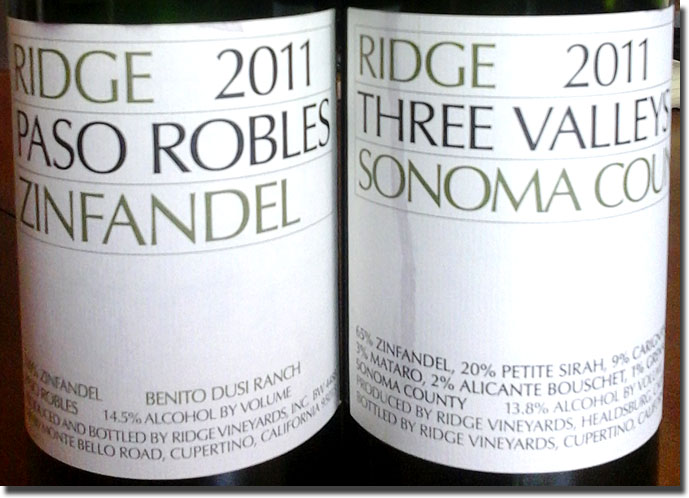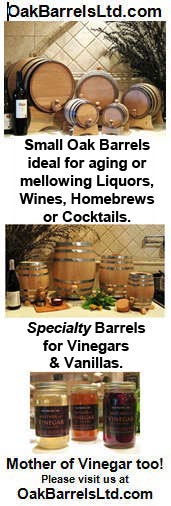A Fistful of Ridge
 During her last visit, Ridge Vineyards Regional Sales Manager, Christina Donley aka “The Donley,” spent her days making the rounds to both on-and-off-premise accounts in the Detroit area sampling some of our favorite wines here at Gang Central. On her second night in town, she came home with four bottles that still had enough left in them so that Kim and I could enjoy a good taste of each. I wasn’t about to try these babies and not take notes, so I pulled out my trusty notebook and pen, put on my old “Bastardo” hat and went to work. (Click images to enlarge.)
During her last visit, Ridge Vineyards Regional Sales Manager, Christina Donley aka “The Donley,” spent her days making the rounds to both on-and-off-premise accounts in the Detroit area sampling some of our favorite wines here at Gang Central. On her second night in town, she came home with four bottles that still had enough left in them so that Kim and I could enjoy a good taste of each. I wasn’t about to try these babies and not take notes, so I pulled out my trusty notebook and pen, put on my old “Bastardo” hat and went to work. (Click images to enlarge.)
2012 Ridge Geyserville® Sonoma County, 71% Zinfandel, 19% Carignane, 7% Petite Sirah, 2% Mataro (Mourvedre), 1% Alicante Bouschet, 14.4% alc., $38.00: Slightly lighter in color than I might have expected, but don’t let that fool you. It exudes lovely Draper perfume, and flavors and aromas are all about well-integrated oak, even at this early stage, and a pretty mélange of red and black berries and cherries; there’s also a note of aquarium on the nose. Even with the air that this got from being sampled all day, the tannin and acid structure is formidable, as one would expect from any good Geezer. I had a glass of this with Kim’s chorizo tostadas and it still needs a minimum of five years in the cellar. Lots of potential here, so be patient.
(For the serious wine geeks, Ridge goes above and beyond to provide tech info like the following on the production of most of the wines on their website.) Harvest Dates: 17 September – 17 October. Average brix 24.5° degrees. Fermentation: Natural primary and secondary; 6 of the 27 tanks were fitted with submerged cap grids, both those and the tanks with a floating cap were given full pumpovers; pressed at 9 days. 100% air-dried American oak barrels (24% new, 25% one and two years old, 51% three and four years old.) Thirteen months in barrel. All estate-grown, hand harvested grapes. Destemmed and crushed. Fermented on the native yeasts, followed by full malolactic on the naturally-occurring bacteria. Six fresh egg whites per barrel to moderate the firm texture of tannins; minimum effective sulfur for this wine (30 ppm at crush; 164 ppm over the course of aging); oak from barrel aging; pad filtered at bottling. In keeping with our philosophy of minimal intervention, this is the sum of our actions. Find this wine
2011 Ridge Lytton Springs Dry Creek Valley, 82% Zinfandel, 16% Petite Sirah, 2% Carignane, 14.4% alc.: Clean color, just a little darker than the Geyserville; aquarium and a hint of dog fur on the nose, with earthy flavors of black and red berries, shaded with a note of the signature Draper perfume. Full bodied, with not quite the acid/tannin bite as the Geezer, but still in need of time; this is a 10-year wine and then some. With air, more fruit emerges on the nose, all warm and fuzzy. A little fatter than the Geyserville, and a little softer, but not much.
Harvest Dates: 20 September – 15 October. Average Brix 24.3 degrees. Fermentation: Natural primary and secondary. Pressed at nine days. 100% air-dried American oak barrels (25% new; 70% one, two and three years old; 5% four years old). Fourteen months in barrel. Find this wine
 Christina says that both the Geyserville and Lytton were really tight that morning, while the following wine “was gushing.” For the record, the Benito Dusi Ranch is the only vineyard in the Central Coast Viticultural Area from which Ridge sources grapes.
Christina says that both the Geyserville and Lytton were really tight that morning, while the following wine “was gushing.” For the record, the Benito Dusi Ranch is the only vineyard in the Central Coast Viticultural Area from which Ridge sources grapes.
2011 Ridge Paso Robles Zinfandel, 100% Zinfandel, 14.8% alc., $30.00: Clean, dark color, with glorious Draper perfume on the nose; sweet spicy oak on the palate, with a generous mix of blackberries and black raspberries, intense and ripe, without crossing the line or going over the top. The Donley mentioned an impression of “Worcestershire sauce.” Full bodied and smooth in texture, yet structured for several years in the cellar. Still, don’t be afraid to open one of these right now, because it gives much pleasure in its relative youth.
Harvest Dates: 5 September – 16 October. Average Brix 25.5°. Fermentation: 100% natural primary and secondary fermentation. 100% submerged cap; pressed at ten days. 100% air-dried american oak barrels (25% new, 7% two years old, 34% three and 34 % four years old). Eleven months in barrel. Hand harvested, destemmed and crushed. Fermented on the native yeasts, followed by full malolactic on the naturally occurring bacteria. A total of 1.3 percent rehydration (added to two of seven fermentors during fermentation). Minimum effective sulfur for this wine (35ppm at crush, 113ppm over the course of aging). Oak from barrel aging. Pad filtered at bottling. In keeping with our philosophy of minimal intervention, this is the sum of our actions. Find this wine
2011 Ridge Sonoma County Three Valleys Zinfandel, 65% Zinfandel, 20% Petite Sirah, 9% Carignane, 3% Mataro, 2% Alicante Bouchet, 1% Grenache, 13.8% alc., $24.00: Perhaps, this has the darkest color of the four we tried on this occasion. It also has the least generous aromatics, with some nice, slightly earthy berry fruit. The most “claret-like” of the quartet, with restrained, but not muted, dark earthy plums and berries, and just a hint of Draper perfume. Easily the most approachable of these four, but obviously, the least substantial; not a bad wine by any means, it’s nice, especially relative to the price. It just has the misfortune of being sampled next to three superior selections. Drink this one now, or the Paso, if you must, but keep hands off the Geezer and Lytton for some years yet.
“The history of the Ridge Sonoma County Three Valleys began with the release of the 2001. The wine contains grapes from a number of Sonoma vineyards – this year, seven. We take great care in selecting the fruit, which is hand-harvested, then crushed and fermented at both Monte Bello and Lytton Springs. Unlike our single-vineyard wines, which reflect the distinctive character of each site, Three Valleys represents the blending of vineyards – winemaking – at its finest. Zinfandel determines the wine’s varietal character; old-vine carignane contributes bright fruit and acidity; petite sirah spice, depth of color, and firm tannins; grenache brings briary fruit and lively tannins.”
Harvest Dates: 19 September – 25 October. Average Brix 23.6°. Fermentation: No inoculation; natural primary and secondary. Grapes fully crushed and fermented in small stainless steel tanks; fermenting juice circulated over the cap twice daily for extraction of color, tannin, and flavor. Full, natural malolactic to soften acidity. Pressed at six days on average.100% air-dried American oak barrels (10% new, 20% one and two years old, and 70% three to five years old). Twelve months in barrel. Find this wine
 Christina also brought a few things with her that we never got to during her stay, so when our partner-in-crime, Alan Kerr aka Canadian Zinfan, arrived the night before he and I were to depart for Electric Forest 2014, he, Kim and I all toasted to The Donley with glasses of this promising youngster.
Christina also brought a few things with her that we never got to during her stay, so when our partner-in-crime, Alan Kerr aka Canadian Zinfan, arrived the night before he and I were to depart for Electric Forest 2014, he, Kim and I all toasted to The Donley with glasses of this promising youngster.
2012 Ridge Sonoma Carignane Buchignani Ranch ATP, 100% Carignane, 13.9% alc.: Clean dark color; shows obvious American oak on the nose, leading to more of the same on the palate, with a solid core of multi-berry black fruit (black currant, blackberry, blueberry). Full bodied, yet sleek, smooth and deceptively well-structured for several years of development, which it needs at this early point. Tight right out of the bottle, so this needs some years in the cellar or at least 30-60 minutes in a decanter, but it has all the goods to a fine Mr. Ridge. 44 Barrels Produced. Find this wine
Reporting from Day-twah,
geo t.
Related posts:




[...] to Day-twah in late May to do what she does so well, sell Mr. Ridge. It’s always tons o’ fun to hang with Christina, and during the course of her stay, we had the opportunity to try some things with her that she [...]